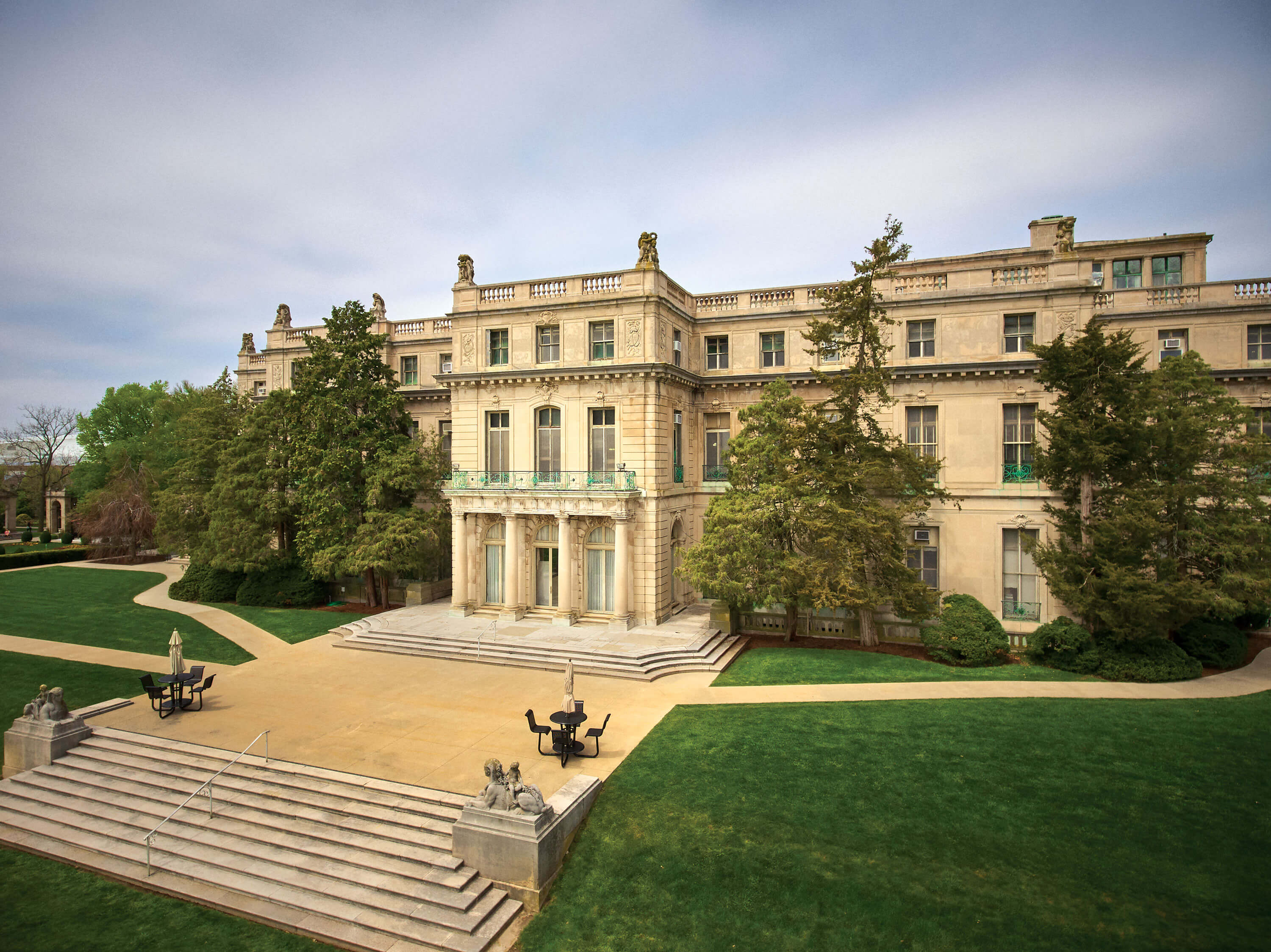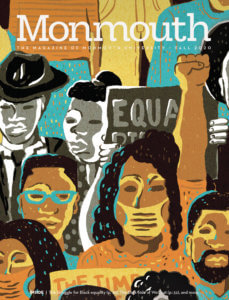
Letters
Readers have their say.
Below are letters written in response the Fall 2020 issue of Monmouth magazine.
Black Women and the Struggle for Civil Rights.

Thank you for the insightful interview with Dr. Hettie Williams (“The Long Struggle”) in which she discussed the ongoing struggle for Black equality. I agree wholeheartedly with her point that the civil rights struggle is about much more than just Black Lives Matter.
Black people, especially Black women, very often face racism in the workplace. It can take many forms: unequal pay, unrealistic expectations, harassment. I know this from personal experience. The struggles that Black people face are indeed real, and much work remains to be done to end systemic racism in America. I’m proud to see my alma mater addressing it in this way.
—Lyreshia (Hailstork) Bonds ’04
In Defense of Wilson
Regarding your Fall 2020 magazine, I am disappointed with your choice of cover artwork. Is it not enough that the mainstream media is constantly showing scenes of violent riots under the guise of “protesting for equal rights”? Monmouth University is supposed to be an educational institution for all in a broad range of occupational fields, not acting as an arm of the liberal agenda.
Moving on to the letter from Fred Dente ’65, “Woodrow Wilson Flunks Out of Monmouth,” I feel his assessment is more opinion-based than historically accurate…. Let us remember that the 1918 H1N1 flu is well documented as the Spanish flu. But true to current revisionist tactics, Mr. Dente places opinion-based blame on America, writing that the flu “was likely to have originated in American training bases and was then exported to Europe on crowded troop ships.” In truth, actual historical and epidemiological data are not adequate to certify the origin of the Spanish flu. It was early identified not only in America, but also in France, Germany, and the UK.
I’d be interested to see reliably sourced, pre-2000 documentation rather than the popular and shameful trend to blame America for everything and see what sticks. Stating something as fact in one form of media does not make it true, although our country is suffering dearly from just that means of spreading fake information. There are more than enough revisionists and cancel culturists mostly doing more damage than good, but where are those who would preserve our history as written, as something to learn from rather than erase?
I’d be interested to see reliably sourced, pre-2000 documentation rather than the popular and shameful trend to blame America for everything and see what sticks. Stating something as fact in one form of media does not make it true, although our country is suffering dearly from just that means of spreading fake information. There are more than enough revisionists and cancel culturists mostly doing more damage than good, but where are those who would preserve our history as written, as something to learn from rather than erase?
Buying in to revisionist history and the destructive cancel culture, Monmouth’s Board of Trustees caved on renaming the former Wilson Hall based on negative sensationalism of Wilson’s life and administration. Rather than taking an in-depth look at the context of the period, the board partnered in the tragic rewriting of historical facts to adapt to today’s hot-button issues, destroying an important part of Monmouth’s legacy for those of us who used to be proud of it.
—Dierdre (Hulse) Egizi ’97M
I disagree with the opinions stated in the letter “Woodrow Wilson Flunks Out of Monmouth.” Wilson was not a warmonger. Just the opposite! In fact, he avoided our entering World War I for three long years despite the sinking of the Lusitania, the number of U.S. merchant ships continually sunk, and the many U.S. civilian lives taken. Does the writer not see the continual taking of American lives as a “definitive or convincing reason” to enter World War I?
There are an incredible number of challenges facing Monmouth University and other similar-sized schools, especially this year. However, the “canceling” of Woodrow Wilson will not solve them for us. What we need is astute management by our leadership and an incredible amount of support from our alumni and friends.
—Paul W. Corliss
Great Hall Memories
Study carrels were on the main floor, and I had classes throughout the building. It was amazing—marbled steps, chandeliers, and the Versailles room. It was unbelievable. The name change is good.
—Diana L. DiFerdinando ’69 via Facebook
I had many classes there in the ’60s. It was a marvelous building. The Winter Balls held in the Great Hall were fabulous, as was the playing of Christmas carols on the magnificent organ. The sound resonated throughout all three floors. There were so many amazing architectural features, as well as the unforgettable marble staircase. I am glad it’s being opened back up to students and hope the integrity of the architecture and decorations is kept as it was when I attended.
—Leah Singer ’69, ’87M via Facebook
A Memorable Win for the Hawks
It was Dec. 1, 1961, prior to anyone even thinking about awarding three points for long-range shooting. Tiny Monmouth College did not yet have a basketball court on campus. The Hawks were still practicing outdoors and playing their “home” games at Asbury Park’s Convention Hall. And they were hosting what was considered, at the time, a small college basketball powerhouse—Long Island University (L.I.U.)—and its All-American, Ed “Cornflakes” Johnson.
It was supposed to be no contest. Many even wondered how Hawks Coach/Athletic Director Bill Boylan even managed to book L.I.U. on the schedule.
A bit more than 1,000 fans were on hand for the big game, and they were becoming discouraged when, with just six minutes left on the clock, Monmouth was still trailing by eight points. But the Hawks lit a fire under their fans by rallying in the closing moments to knot the score 64–64 on a driving layup by Hank Arning before time expired. Then, Monmouth’s Bruce “Hot Thumbs” Beckman poured in six points and George Gill two in the five-minute overtime to put the game in the Hawks’ win column, 72–70.
Beckman wound up with a game-high 32 points, hitting mainly on booming jump shots from 25 to 30 feet. He also made two clutch free throws with 20 seconds left to give Monmouth a 72–68 cushion. Walt Mischler scored 18 points and pulled down 16 rebounds before fouling out late in the second half. The Hawks’ 66-inch sparkplug, Barry Ayers, continually out-hustled everyone and wound up with 10 rebounds. When Ayers fouled out with two minutes remaining, Gill, his replacement, stole the ball at half court and dropped in the basket that cut the margin to two points, 62–60. Arning, a 6-foot-1 freshman, made several key baskets and finished with 14 points.
That scintillating overtime victory propelled the Hawks to prominence in NAIA circles nearly 60 years ago. Phew! And Mischler went on to earn NAIA All-American honors. It was a glorious Monmouth sports moment.
—Chuck Hassol ’61A
Paddy’s On My Mind
Paddy Murray’s was my favorite hangout during my junior and senior years back in the early days of Monmouth College. It was in Paddy’s quiet and comfortable surroundings where many of us would be able to sit at the bar or at a small table and carry on conversations. It was a wonderful place, full of Paddy’s own antiques. He trusted his clientele within the atmosphere he established. There was no dancing; yes, there was music on the jukebox, but it was Tony Benne (Paddy’s favorite) or Ray Charles singing “Georgia on My Mind.” Even a rock ‘n’ roll lover such as myself welcomed the quieter atmosphere for many evenings with my Monmouth classmates. After I graduated in 1961, Paddy’s remained the place to spend an evening until I left the area in 1967. It was an original Monmouth hangout.
—Ron Emmons ’61